Site Menu:
| This is an archived Horseadvice.com Discussion. The parent article and menus are available on the navigation menu below: |
| HorseAdvice.com » Diseases of Horses » Lameness » Diseases of the Hoof » Navicular Disease / Chronic Heel Pain SynDrOme » |
| Discussion on Punky diagnosed with CHPS | |
| Author | Message |
| Member: leslie1 |
Posted on Friday, May 29, 2009 - 5:50 pm: The vet, an equine lameness vet, saw Pumpkin today. Gave her a PDN that blocked out on her right front. Diagnosis: CHPS.She is sound on her left front. even after her right front blocked. He did not think x rays were needed at this point. (and MRI is out of the question $$) He recommended Egg Bars with a 3* wedge, 5 days of bute, 3 days of stall rest, 2 days turnout and then back to work. If she doesnt get better then x rays with possible injection. The vet did say if my farrier wanted to try something else then that would be fine. My farrier thought a straight bar shoe with the 3* wedge would be better for her. DrO Do you have any thoughts on this ( the unilateralness of it or the treatment) Anyone else dealing with this? Its a bit disheartening. I did read Dawn's tildren post---I wish they would approve that drug soon. I think I will have a glass of red wine or a Guinness stout and relax. |
| Member: dres |
Posted on Friday, May 29, 2009 - 6:39 pm: Well this stinks.. but without an x ray you really don't know exactly what you are dealing with correct? I am dealing with CHPS on my gelding..with x rays we know that both front hoofs are dealing with something different.. * great* anyway after years of shoeing and trying different things i found these shoes with pads..https://tenderhoof.com/m_33.asp have been using them now for a year.. and my horse is going well for my grand daughter.. i am getting by with resetting the aluminum in the winter when he is not ridden much.. Also i manage him with a gram of bute on the days she rides and he is fed MSM in his pellets.. Good luck .. it is not the end of the road.. On the first day God created horses, on the second day he painted them with spots.. |
| Member: scooter |
Posted on Friday, May 29, 2009 - 7:04 pm: Bummer Leslie, I have to agree with Ann CHP can be caused by many things. Did your vet have an idea why she has CHP?You may have to "play" with her shoeing to see what makes her most comfortable. With a good farrier you may be surprised how soon she turns around. Good Luck! |
| Member: leslie1 |
Posted on Friday, May 29, 2009 - 7:11 pm: Hi AnnFor now, he didnt seem to think xrays would be anymore conclusive than the PDN block. He seem fairly optimistic about the shoeing and wedges. Perhaps because she is a pleasure/trail horse and not in any really intensive work. Thanks for the tenderhoof website. I really like those shoes. Its also amazing to watch them rebuild the hoof with glue and then pare it away just like hoof horn! neat. As an aside-one of the other horses their got cast in her stall and slashed open her eye really bad...so I got to see him stitch that up too  It was EWWWWWW (as my daughter would say 
|
| Member: leslie1 |
Posted on Friday, May 29, 2009 - 7:20 pm: DianeEHe didnt say what he thought caused it. I do know that when we moved here my then new farrier definatly did NOT like the way my AZ had been doing her. |
| Member: scooter |
Posted on Friday, May 29, 2009 - 7:52 pm: Are you brave enough to post pics of her hooves?
|
| Member: leslie1 |
Posted on Friday, May 29, 2009 - 8:16 pm: I am she is at the trainers and I will go out there next weekend at take some-- she is at the trainers and I will go out there next weekend at take some-- K, ... trainer just called and said the farrier did her feet tonight in eggbars. I have 2 different pics of her that show her feet. Both are when she was in AZ. I have to get hubby to scan them and then I will try to post them. |
| Member: leslie1 |
Posted on Friday, May 29, 2009 - 9:17 pm: Here she is in AZ....her heels look underrun.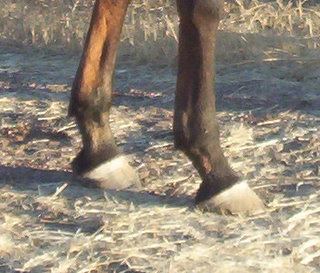 Here she is in KY with alot higher heel. 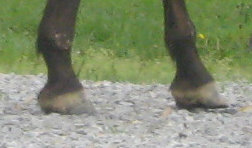 here she is being all purrty and stuff  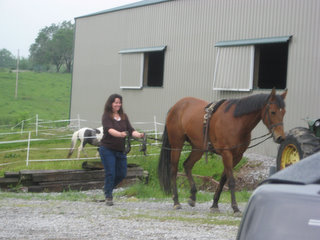
|
| Member: vickiann |
Posted on Friday, May 29, 2009 - 9:24 pm: Maybe it is just my eyesight and I won't claim to be an expert, but the hairline on the KY photo of the front right looks distorted to me as though the hoof capsule has remodeled. |
| Member: scooter |
Posted on Friday, May 29, 2009 - 9:43 pm: HMMM the pics aren't good enough to judge, but thanks for trying! IF I HAD to judge the hooves in the 1st pic SEEM to look better. Do you have any recent better pics of her hoof from the sideHigh heels aren't necessarily a good thing either. Balance of course is most important and figuring heel height has always been a problem for me, tho the foot should tell you where it belongs I suppose. Was she lame in AZ with the other farrier? |
| Member: vickiann |
Posted on Friday, May 29, 2009 - 9:48 pm: I agree with Diane that the pics in the first photos look better, though again stress that I am no expert.And Diane also makes a good observation about high heels. |
| Member: leslie1 |
Posted on Friday, May 29, 2009 - 10:16 pm: I broke her last summer. She started getting gimpy at the end of summer. Before that she never worked a day in her life...never lunged and never was lame in pastureThe 2nd picture is from a weird angle, her right is farthest back and the left is veiw from almost behind. ...here is the whole photo uncropped. 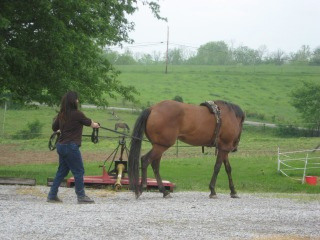
|
| Member: lilly |
Posted on Friday, May 29, 2009 - 11:00 pm: Leslie,When my horse Isabella was dealing with heal pain (confirmed with a block) I tried using Morrison roller shoes and she did really well in them. Here is a link: https://www.grandcircuitinc.com/proddetail.asp?prod=MORSGCMOR She did great with these shoes. No sign of lameness. Eventually she got worse and an MRI revealed that she had been dealing with a chronic tear in her DDFT all along. An additional, new tear put her over her pain threshold and she is now on a year stall rest. |
| Member: scooter |
Posted on Saturday, May 30, 2009 - 7:42 am: Leslie how was punky with her new shoes? Yea those pics aren't good enough too say anything really.Just follow your vet and farriers advice and see what happens  They are the ones that can see her hooves and examine them. They are the ones that can see her hooves and examine them. She is a very purty horse 
|
| Moderator: DrO |
Posted on Saturday, May 30, 2009 - 8:37 am: As the article on this subject notes, CHP is not a diagnosis, it is a localization of where the lameness is coming from.If your veterinarians current recommendations do not help the article explains a step wise method of further defining the location and cause. This is the best way to define the best treatment and prognosis. Concerning the images the shots are too irregular to say anything but a good set of confirmation shots of the lower legs might be helpful. DrO |
| Member: leslie1 |
Posted on Saturday, May 30, 2009 - 9:14 am: THanks to all and to Ann for the link. and to Ann for the link. DianeE we wont know how the new shoes help until after her 5 days of rest. She is only noticeable lame on the lunge at trot. She troted a straight line sound looking. It sounds like treatment will be a hit or miss  Thanks again L |
| Member: leslie1 |
Posted on Wednesday, Jun 3, 2009 - 8:22 pm: Tonight Pumpkin was longed for the first time since rest and shoeing. Last night was her last dose of bute. She has improved markedly but not completely 100%. Since she is at the trainers for another 2 weeks I am considering having them continue with the bute so she can finish her training and then when I get her home try to figure something else out, so she can hopefully be ridden comfortably without meds.I read the article on NSAID and it said to give bute a few hours before the ride and then after. I am considering having them give her 1/2 gram in the morning and another 1/2 gram after the training session in the evening. If that doesnt work I am will bring her home early 
|
| Member: dres |
Posted on Wednesday, Jun 3, 2009 - 8:35 pm: L, i give my boy a gram in the AM on the days the grand daughter rides... nothing afterwards... what i have found tho.. is that he feels even better if i give him a gram the day before she rides as well.,. don't know if accumulative is helping or not.. So my boy gets about 3-4 grams a bute a week for his work..On the first day God created horses, on the second day he painted them with spots.. |
| Member: leslie1 |
Posted on Wednesday, Jun 3, 2009 - 8:55 pm: Thanks Ann,I was wondering about that...If the half life of bute is 8 hours perhaps it would be best to give the full dose a few hours before the session. I also am considering bedding an area of her stall where she likes to stand with sand. (Since they are usually turned out 24/7 I normally dont bed the stall.) Thanks for the input: it is soo good to hear that it is managable. Especially coming from someone I kinda know (atleast online) |
| Member: canter |
Posted on Thursday, Jun 4, 2009 - 7:33 am: Very glad she is improving Leslie...hope it continues to 100%! |
| Moderator: DrO |
Posted on Thursday, Jun 4, 2009 - 7:41 am: I agree for a thousand lb horse 1 gm am before exercise and 1 gm pm after the exercise is going to be more effective. Remember there are two actions of a NSAID. The first is pain relief and the second is the antiinflammatory action. The first has a few hours onset and wanes over the following 12 hours with a measurable decrease in the first 12 hours. In the second case it can well take days to weeks before resolution and can result in weeks or months of improvement after discontinued.DrO |
| Member: shanson |
Posted on Thursday, Jun 4, 2009 - 5:36 pm: So has she been lame since last summer (or a year)? How long of a rest have you been able to give her? If it's soft-tissue injury, some can take a very long time to heal. |
| Member: leslie1 |
Posted on Thursday, Jun 4, 2009 - 6:34 pm: HiSo I talked with her vet this mornng, he actually got to take a peek at her as he was out at the trainers for the mare that got the eye stiches and he was very pleased with punky's improvement and said he thought we can get 100%. He agreed with finishng her 2 weeks of training with the bute and then give her some time off once I get her home and see how she does after a few shoeing cycles  Shannon, I started her last summer---her first real longeing and riding. In the begining I had her warm up in an arena-free longeing, at that time I notice she seemed stiff going to the right and chocked it up to her being one-sided. Lost access to the aREna and started longeing her on a line but noticed by end of summer she was a little more *off*--not head bobbing lame. Thought perhaps she has thin soles or a bruise(tested neg to hoof tester) but decided to shoe her anyway...didnt really help and since it was at the end of summer I decided to pull her shoes and give her some ttime off. She popped a gravel 2 or 3 days after I pulled shoes. So I thought that maybe that was the prob. Stricktly turned out all winter...no riding or longeing. No noticeable lameness in pasture. Fast forward to spring I decide to send her to a trainer to get some expierence as a field hunter...creek crossing etc. Well the first time they try to longe her she is a bit off(only going to the right)...2nd day a little bit worse so I decide to get to the bottom of it and have the vet out. He seems very optimistic. YAY! I do love the broad! And cant wait to see her Saturday with my own 2 eyes and check her. Its been very hard not having her here to manage this myself. Its been a test in learning to let others take care. But I do have to say the trainers have been wonderful in keeping me updated everyday with her. Infact I usually get a call and an evening email from them.(even though she has been on stall rest mostly LOL) So that has helped. |
| Moderator: DrO |
Posted on Friday, Jun 5, 2009 - 8:16 am: Sounds like good news leslie.DrO |
| Member: leslie1 |
Posted on Friday, Jun 5, 2009 - 2:23 pm: YES, and I am so thankful
|
| Member: leslie1 |
Posted on Thursday, Jun 11, 2009 - 8:22 pm: Well, Punky had 3 days off of bute and exercise. When put back to work (on 1 gram bute) she was gimpy. So it sounds like she only goes sound when the bute is built up in her system.(?)I decided to bring her home early. She'll be home saturday and I am looking forward to seeing her. Her feet get done on the 26th. We will try a different shoe. L |
| Member: scooter |
Posted on Thursday, Jun 11, 2009 - 9:07 pm: Leslie I swear by the equipak with a wide rim shoe. Seems to cover all the bases.Many people have success with it for varying problems, including CHP. I have seen it turn around a "navicular"/ CHP horse in a few days...if applied right  and of course the correct trim. and of course the correct trim.
|
| Member: leslie1 |
Posted on Friday, Jun 12, 2009 - 11:42 am: Thanks DianeI just looked it up. I think Ive seem some of that in my farriers truck. I will ask him about it. My vet did suggest a wide rim once we take her out of the egg bars. Cheers L |
| Member: leslie1 |
Posted on Friday, Jun 12, 2009 - 3:57 pm: I bought a small truck load of sand for my kids sand box and have enough to some put in Pumpkins stall. She likes to stand with her head sticking over her stall door and usually can be found there a few hours of the dAY. My questions: Since I am only bedding the spot where she likes to stand,probably a 4X3 area, can I put it 6 to 8 inches deep? Or will standing in sand that deep cause any strain ? Will sand interfere with any shoes/pads/equithane that we may have to try in the future?PS...I dont bed their stalls cuz they sleep in the pastures. I was planning on renovating stall floors with stall skins but since she needs shoes that kinda kaputz that idea. Thanks a bunch Leslie |
| Member: scooter |
Posted on Friday, Jun 12, 2009 - 5:56 pm: Hi Leslie, 6-8ins. sounds pretty deep, but if she is just standing in it I can't see where it would do any harm...won't it spread out into the rest of the stall anyway?? |
| Member: leslie1 |
Posted on Friday, Jun 12, 2009 - 7:55 pm: Yea it'll probably spread but I already had the stall floors prepped and compacted for the renovation. So I thought maybe give her something soft to stand on until I re-figure how I want to do them. (Although...I just found some new mats on CL for $20each ) ) I do wonder about the sand that deep because I think since her CHPs is only in one foot-- its probably from her Navicular apparatus rather than the Navicular bone. I ended up spreading the sand thinner JIC. Thanks D L |
| Member: leslie1 |
Posted on Friday, Jun 12, 2009 - 8:38 pm: She got worked tonight(got 1 gram at 2 pm)...no limping at all.ARGGGGH. |
| Member: scooter |
Posted on Friday, Jun 12, 2009 - 10:53 pm:  and did you expect anything else?? and did you expect anything else?? horses........... Put on earth to drive us nuts...good thing they are cute and cuddly! |
| Member: leslie1 |
Posted on Saturday, Jun 13, 2009 - 8:05 pm: LOL DI brought her home today and she is cute and cuddly. And is like "Gosh MOM, leave me alone!" 
|
| Moderator: DrO |
Posted on Sunday, Jun 14, 2009 - 7:00 pm: I would limit the sand to 2 inches but whether it should be used at all or not depends on the surface you have now: is it too hard or uneven to be comfortable? Or is already sandy soft. If too deep the horse's heels may sink a bit and put pressure on the deep digital flexor/navicular area.DrO |
| Member: leslie1 |
Posted on Sunday, Jun 14, 2009 - 8:46 pm: Thanks DrO, I will thin the sand down to a couple of inches.My stalls are stripped and compacted down in prep for new flooring with mats. I keep the horses turned out and they stay in the pasture 20 some hours a day. But when she comes in to drink she usually likes to stand at the stall door so I put a bunch of sand in front of the door where her fronts would be. I probably cant afford to finish the stalls with mats for another month or 2. Much appreciated  L |
| Member: leslie1 |
Posted on Wednesday, Jun 17, 2009 - 1:42 pm: DrO and othersIs the Capsaicin the same stuff I can pick up in my pharmacy or is this different and should be obtained by my vet? Thanks L |
| Member: scooter |
Posted on Wednesday, Jun 17, 2009 - 3:43 pm: OH Leslie, be careful with that stuff! I tried it when I hurt my knee and it burnt so bad I couldn't stand it. Stood with my knee under cold running water for about an hour and it still burnt! I was going to try it for Flash's arthritis, but after that experience changed my mind....I have some here if you want me to ship it
|
| Member: canter |
Posted on Wednesday, Jun 17, 2009 - 3:55 pm: Leslie, it's an ingredient in many otc topical analgesics. And Diane is right - it can burn like heck. I don't have sensitive skin, but that stuff makes me feel like I'm being roasted over a fire. I'd use extreme caution if trying on a horse. It definitely does not clean off easily and you may end up with a problem. |
| Member: leslie1 |
Posted on Wednesday, Jun 17, 2009 - 8:29 pm:  I can see applying it would soon become a nightmare, I can see applying it would soon become a nightmare, plus I bet it would cause them to stamp alot(?) |
| Moderator: DrO |
Posted on Thursday, Jun 18, 2009 - 7:39 am: Capsaicin is the same everywhere but concentration and carrier bases will differ markedly. The article gives a recommended concentration so check the labels but I still think it is wise to be careful when you start.DrO |
| Member: canter |
Posted on Thursday, Jun 18, 2009 - 7:45 am: ...or go right up in the air, Leslie.Funny story that illustrates how this stuff can burn: Years ago, I was working in a sort of warehouse, and spent a lot of time unloading trucks. Cases of paint are very heavy, so after a big truckload and some sore shoulder muscles, I went into the ladies room and slapped on some ointment (don't remember which brand)which contained the capsaisin. It was winter, and the warehouse was cold, so I had layers on: a turtleneck, sweatshirt and vest. 'Bout half an hour later, I was talking to a sales rep, when I started to dance around and swear. It literally felt like someone was branding my shoulder with a hot poker. Much to the amazement of everyone I was working with, I ripped off the vest, pulled the sweatshirt over my head and pulled up the turtleneck from the bottom and gathered it around my neck and started shouting, "Get it off! Get it off!" Fortunately, the sales rep was a lovely older lady who had become a friend. She grabbed a handful of baby wipes and started wiping off the remainder of the ointment. Unfortunately, most of it had soaked in and I had to wait it out...with tears in my eyes. It really hurt! So, I can only imagine the kind of reaction a horse might have if it gets the same burning at the stake feeling! 
|
| Member: scooter |
Posted on Thursday, Jun 18, 2009 - 7:51 am: Yea I'm with fran. That stuff won't wash off if you start burning, I used soap and scrubbed and scrubbed while holding my knee under a cold shower . If you use it do a tiny test spot 1st! . If you use it do a tiny test spot 1st!
|
| Member: kpaint |
Posted on Thursday, Jun 18, 2009 - 7:56 am: Good to know Diane et. al. I won't be using that stuff on my knee... |
| Member: leslie1 |
Posted on Monday, Jun 22, 2009 - 8:15 pm: Punky threw her shoe today. Farrier was scheduled for tomorrow anyway, so I put her in the round pen which has the best footing. (still dont have my stalls done)I took these pics tonight. The lame foot is her RF. She is on week 4 of her shoe cycle. 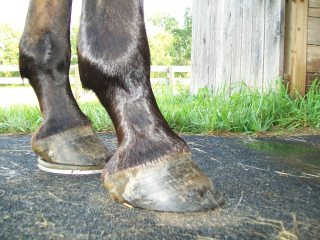 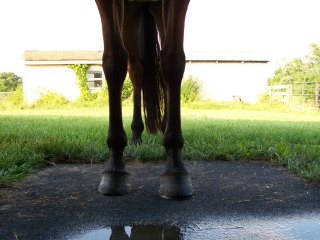 LOL Im not sure how to take a good foot shot? Thanks L |
| Member: canter |
Posted on Tuesday, Jun 23, 2009 - 7:06 am: Leslie, do you keep her in bell boots? I have found that it really helps in cutting down the frequency of pulled shoes.From your pix, it looks like she didn't do too much damage to the hoof itself, which is always good news. |
| Member: leslie1 |
Posted on Tuesday, Jun 23, 2009 - 11:58 am: FranI picked up some of the 'jelly' bell boots at TS yesterday. I swear, she must of thrown it while I was picking them up at the store  .... .... I had her in my ballistic ones... but with all mud/rain lately I took them off. TY L |
| Member: leslie1 |
Posted on Sunday, Jul 12, 2009 - 8:40 pm: What does this picture suggest? Are her angles off? Why would pads and wedges be advised? This photo was taken a week after I had them remove her eggbars/wedge/pads and its abpout a week old trim.I have some people saying she needs a 30* degree angle and others saying she needs wedges. I am confused. 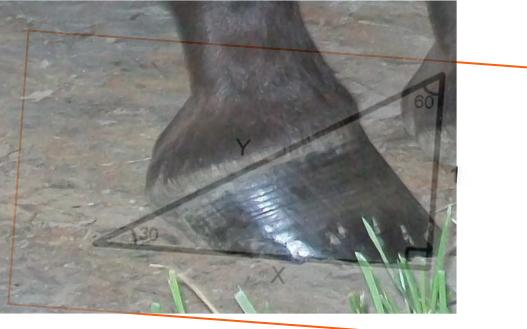
|
| Member: leslie1 |
Posted on Sunday, Jul 12, 2009 - 9:15 pm: Heres a 2nd one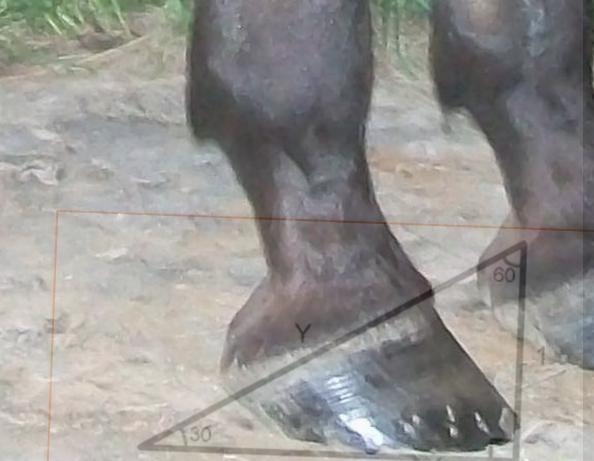
|
| Member: rtrotter |
Posted on Sunday, Jul 12, 2009 - 9:46 pm: Leslie,What I see here is long toe, low heel. This would put a lot of strain on her tendons and also cause her to be sore in her heels. This horse needs a proper trim with toes backed up and beveled and her heels left alone to correct themselves.I can't see how the structures on the bottom of her foot look, but I can almost guarantee that the front part of her foot from the widest part of her hoof (side to side) is longer than the back half from the same point. That needs to be corrected. When I hear people putting their horses into pads and wedges when there still is a balance problem, I cringe. IMO you will never correct this foot or her problems until her foot is balanced.and only then will you be able to tell if she truly has CHPS or its just an unbalanced foot that is causing the problem. If you have the money I would take some xrays and look at the angle of the coffin bone as it relates to the ground surface. If its pointed down thats a problem, if its parallel thats ok. Farriers and some people think that raising the heels with wedges and pads corrects the problem. It does not, in fact it makes it worse and may create other problems as the horse tries to compensate for the unnatural angle. This foot needs a proper trim to make it better and it may take several trim cycles (with in between refining) to completely correct. You just need a little patience,some time and a proper trim. Now, that I got that off my chest, I'd like to relate a story. One of the best farriers on the east coast remarked to me that he wished every horse could go barefoot because most if trimmed and conditioned correctly do not need shoes ( we are talking racehorses here). This guy does corrective shoeing on some of the biggest named standardbreds and works for some really big operations in the business. However, he said that since his business is corrective shoeing he'd be broke and out of the business very quickly because he'd make no money dealing with healthy footed horses that didn't need a $1000 a set of shoes to race in. I think there is a lot of truth in what he said. Farriers are in the business to make a living, they will not make a living on trimming horses. They make their living on the labor it takes to shoe a horse( horseshoes and nails are very inexpensive), but the labor to put them on is a bear. Rachelle |
| Member: scooter |
Posted on Sunday, Jul 12, 2009 - 9:52 pm: Hi Leslie, welcome to the world of confusing hooves . I don't know for sure what is meant by the angles, but it would appear it means she has the long toe long heel thing going on, tho I will say I have seen way worse! . I don't know for sure what is meant by the angles, but it would appear it means she has the long toe long heel thing going on, tho I will say I have seen way worse! If you haven't read this yet it would be a very good start to understanding https://www.horseadvice.com/horse/messages/4/151283.html Hank has that going on too, we have slowly...very slowly been correcting it. I have not used wedges, just the WW shoe and equipak when we started, now just the WW shoe. He needed the equipak at first because he got sore when bringing the toe back. He has other issues tho as you know. |
| Member: scooter |
Posted on Sunday, Jul 12, 2009 - 9:57 pm: PS I think getting some x-rays would go a long way in helping to decide her shoeing and what her problem is
|
| Moderator: DrO |
Posted on Monday, Jul 13, 2009 - 8:35 am: leslie, it is near impossible to give an accurate reading of balance without good lateral views of the feet that include the cannons so we can assess whether the horse is standing square. If we back up to your Jun 22 posting I think it supports the idea of a mildly out of balance foot with the toes a bit long and heels a bit low. The foot with the pads appears to correct this imbalance.DrO |
| Member: leslie1 |
Posted on Monday, Jul 13, 2009 - 10:14 am: Thanks to all.I re read the long tow low heel and think I am understanding better. I do need xrays. |
| Member: rtrotter |
Posted on Monday, Jul 13, 2009 - 3:11 pm: Dr. O,I would be very curious to see a set of x-rays of the left front with the shoe and pad on to see if the angle of the coffin bone is negatively affected by the shoe and pad. while this may "look better" asthetically, I do not believe the shoe and pad combination "corrects" the problem. Before I got into the barefoot movement and started to understand what was going on with my horses feet, I was also the victim of improper thinking about how to raise a horses angle.( degree pads, wedge shoes and chopped off toes with no regard to where the break over point of the foot was. Now I know better and when I correct my horses feet now they are corrected barefoot with an aligned bony column starting from the coffin bone and going up the leg. Not only does the HPT barefoot trim fix the feet, but it also fixes many of the problems associated with the skeleton of the horse starting at foot level and going up. Just my thoughts Rachelle |
| Moderator: DrO |
Posted on Tuesday, Jul 14, 2009 - 9:44 am: rtrotter, the lack of remarkable pathology in the horn strongly suggests that the hoof capsule accurately reflects the positioning of the coffin bone. The one reason I might want a radiograph to help balance the above foot is if I had trouble with determining sole depth or if there was solar pathology consistent with rotation.DrO |
| Member: rtrotter |
Posted on Tuesday, Jul 14, 2009 - 3:23 pm: Dr. O,Let's back up a bit. The horse blocked sound when the right front foot was blocked. I believe this was before the shoes were put on. So, technically there was nothing wrong with the left front foot, and as you say the horn does not show any remarkable pathology. Now, we put on a wedge shoe and a degree pad on a sound foot, what does that do. It changes the angle of the coffin bone from where it was and should be to a negative angle. Now, putting this wedge and pad on the right front foot with the problem may have helped temporarily, but IMO over time and if these shoes were left on this horse for any length of time other problems would have arisen and Leslie would have been scratching her head trying to think about the next set of problems, when it was really unbalanced feet all along. Horses sometimes have four different shaped feet and each foot should be balanced on its own merit. At the same time why would you want to fix a hoof( balance yes, fix not) that does'nt have a problem, just because you need a correction on the other foot. Seems to me Leslie needs to find the cause of the CHPS and fix that before she puts any shoes on this horse. I'd rather see this horse in a soft set of boots first, before I'd put shoes on her. Another much simpler solution would be to go with a Yasha padded regular riding horse shoe that protects a horses heel, but does not have a wedge or a degree pad. www.tenderhoof.com ( This was mentioned earlier in this thread) Ok, I'll get off my soap box again. Rachelle |
| Member: leslie1 |
Posted on Tuesday, Jul 14, 2009 - 4:36 pm: Thanks both DrO and Rach.Ive always wondered about the fact she went sound on both after the Nerve Block. (which BTW, I found out after I got the bill, wasnt even a PDN, it was an plan ol' abaxial.(?) She was barefoot at the exam. No swelling or heat or DP. I think he flexed her fetlock as he did bend it up, but he didnt have me walk her after he bent it, so IDK. It seemed to me she was the same in the eggbar/wegde combo as she is barefoot. grade 2/5. I do admit I only kept her in the eggbars for 1 cycle...as she threw one and I decided not to have her re-shod. Perhaps I didnt give them enough time. As I try to educate myself it seems I need to give each attempt of different things atleast 4 or 5 cycles. I am waiting until her next trim to size her hoof and then get her a pair of EB epics /pads.(rachelle, what strength of pad? Ive heard the soft ones are a waste of $ as they wear out very quickly, would you use the ones with the frog or just plain?) Atleast I'll have them even if I have to put her back in shoes. Thanks for the brainpower  L I will get a set of xrays done soon, hopefully. I am going to get both fronts done. So that I have a refernce point if she ever does show lameness on the LF. |
| Moderator: DrO |
Posted on Tuesday, Jul 14, 2009 - 6:45 pm: We are discussing to different issues rtrotter. The diagnosis of the (1) CHP and (2) trimming to balance the foot. I have already stated (months ago) above more needed to be done on the diagnosis of the CHP and the reference I give has a step wise diagnostic approach that includes radiography.Above we are discussing ap balance of the foot, that I do not believe requires radiography unless the conditions above apply. DrO |
| Member: dres |
Posted on Tuesday, Jul 14, 2009 - 7:16 pm: I am the one who uses the Yasha padded shoe, I order them every other shoeing.. all tho , my horse on his left front does have a wedged shoe built in the aluminum with the Y pad set on it.. In that hoof he has a avulsion fracture of the navicular bone.. and the wedge has done wonders for him along with the pad for his OTHER issues..On the first day God created horses, on the second day he painted them with spots. |
| Member: rtrotter |
Posted on Tuesday, Jul 14, 2009 - 8:56 pm: Ann,You are doing the right thing by protecting the hoof with the fracture. You are also using the Yasha pads for the right reason, to protect your horses heels. The reason these pads work so well is that they are very resilient and tend to not get destroyed and compacted as the horse gets further and further into his/her shoeing cycle and thus protects the heel from crushing much longer than normal pads. You also are not shoeing both feet the same because you are not dealing with the same problem in both feet. In your horses case he probably can't go barefoot because of the fracture. Dr. O, while these may be separate issues, to me they are related, in the earlier set of pictures, first we have what appears to be crushed heels, which are probably contracted as well and then we have heels that are way too high and in the last set we have heels that are too low with a long toe. No wonder this mare is sore, her feet can't get it together and neither can the farriers. Leslie, the next time you have your farrier out ask him if he knows the difference between a field trim and a natural trim. Also ask him if he knows what a mustang roll or a beveled toe is. You would be surprised at how many farriers do not know the answer to these questions. You might also want to ask him if he knows where a particular horses breakover point is or how to correctly find it. Before I went out and bought boots or pads, I would see if fixing her feet would help first. However, if you do not have someone that can fix her and know what they are doing, then I would look into the other options. Rachelle |
| Member: leslie1 |
Posted on Tuesday, Jul 14, 2009 - 9:34 pm: Thanks Rachelle. When we moved here we did have a problem getting a certified farrier to come to our place (in the middle of no=where) I ended up with this guy cuz I called and kept bugging the closest CJF I could find. That would take on a client that has only 2 horses.Everyone seems to wo9rk for the huge Tb and SB farms.L |
| Moderator: DrO |
Posted on Wednesday, Jul 15, 2009 - 6:19 am: trotter, you stated a specific reason for radiographing above that I disagree with for the reason I state. I do not disagree that radiography for a better diagnosis is a good idea.But I find myself disagreeing with you again over the earlier assessment of images. I do not find the images in the first photos show heels that are "way too high" as the images are not good square standing laterals on a flat surface. Neither do I see evidence of either crushed or contracted heels. I see horses with the above foot conformation everyday without such changes, though they do not rule it out either. I would be cautious in overinterpreting whether a farrier knows what a particular term means and we should note there are many differences of opinions on how to determine breakover point. I give my own favorite in our articles but I have heard at least half a dozen different ideas on this each by a world recognized figure. If I appear to be nitpicking I apologize but online advice has to be very careful about assuming too much. DrO |
| Member: leslie1 |
Posted on Friday, Sep 18, 2009 - 8:19 pm: DrOThinking back to last winter I remember Pumpkins feet being Very cold...ice cold. I think it lasted for about a week or two then went back to a normal feeling temp. She wasnt in shoes and has access to turn out 24/7. I remember thinking how odd it was. Is that an indication for some kind of circulation/navicular. and I am wondering if Isoproxine would be of benefit. I guess as your article states..its cheap and cant hurt. Do you consider it odd too? I forgot to tell my diagnosing vet about it when he examined her. Thanks Leslie |
| Moderator: DrO |
Posted on Saturday, Sep 19, 2009 - 9:28 am: I often find normal horses hooves temperatures vary widely with changes in the environment and use leslie. I guess I have problems when you say "return to normal" as horses feet normally vary quite remarkably. The foots temperature is much more significant when correlated to clinical signs that refer to the foot.DrO |
| Member: leslie1 |
Posted on Saturday, Sep 19, 2009 - 9:49 am: Her feet definelty vary depending on what shes doing.But Ive never, ever felt them so Ice cold as to literally feel like an ice cube and painful for me to hold while picking I guess when we owners get a diagnosis like Nav or founder or whatever we wrack our brains trying to get the when, how, what, coulda, shoulda's. |
is The Horseman's Advisor
Helping Thousands of Equestrians, Farriers, and Veterinarians Every Day
All rights reserved, © 1997 -
